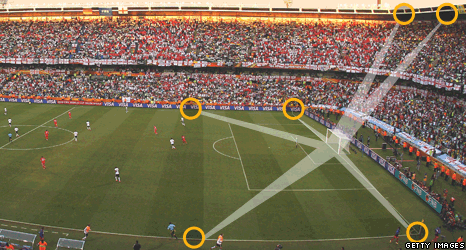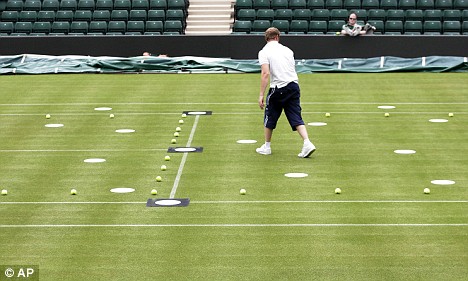Triangulation against the Doppler effect: a technology battle on the football field

Triangulation of the ball on six video cameras in the Hawk-Eye system, accuracy of 3.6 millimeters, 25% of the ball should be visible
The International Football Association Council (IFAB) has started the final tests of the ball tracking systems at the intersection of the goal line. On July 2, 2012, at a special meeting in Kiev, the IFAB Council must make a final verdict and officially amend the football regulations if it approves one (or both) of the technology.
The start of the competition was initiated by FIFA in July 2011 by publishing technical specifications . Initially, 12 systems were announced to participate. Eight participated in the first tests in the fall of 2011, and two came to the final: Hawk-Eye and Goalref.
Unfortunately, only four of the eight systems that participated in the initial testing were able to find information.
')
1. Cairos GLT (developed by Carios Technologies AG, Germany): based on a magnetic field with a radiator inside the ball (Adidas ball), thin cables buried along the lines of the penalty area. The previous version of the system was presented in 2005, but it was rejected.
2. Goalminder (development of two English enthusiasts): involves the introduction of two video cameras that shoot video at a frame rate of 2000 fps into the goal posts, it works only as a video replay system, so the referee must visually view the controversial point.
3. Goalref (developed by the Institute of Integrated Circuits of the Fraunhofer Society, Germany): To register the ball crossing the goal line, the Doppler effect from the emitters in the ball crossing the magnetic field is used. At the same time, it is not necessary to place the radiators in the very center of the soccer ball, like in Cairos, they should be close to the surface, and you can insert them into the ball of any company.
The exact specifications of the technology have not yet been published in the public domain, but there is an application to the US Patent Office with a brief description. Although there we are talking about "oval balls", but this is clearly the very technology Goalref. There is a European patent .
In addition to Goalref, the Fraunhofer IIS institute promotes the RedFIR 3D-visualization system to track ball movements and footballers around the field (it looks like radio tagging is planned to be sewn into athletes' T-shirts).
4. Hawk-Eye ( Hawk-Eye , developed by Hawk-Eye Innovations Ltd., UK): a well-known and well-tested system created by Dr. Paul Hawkins in 1999 and subsequently patented. To determine the position of the ball using the method of triangulation. The site is filmed by at least six high-speed cameras located along the perimeter. The measurement error is 3.6 mm. Currently Hawk-Eye is used in tennis, snooker, volleyball, cricket and other sports.

Hawk-Eye system calibration before a tennis match
The disadvantage of Hawk-Eye is the high cost, as well as technical limitations - to trigger a computer system, it is necessary that at least 25% of the ball be in the field of view of the cameras. The advantage is in entertainment, because the repetition of dangerous moments rendered in a 3D program will surely cause a lot of thrill to the fans.
Two systems entered the final round of IFAB testing: Goalref and Hawk-Eye, both of which were tested in May for a number of low-ranking matches: Goalref in Denmark, and Hawk-Eye in England. In June, the last test round will begin: Hawk-Eye will be put up at a friendly match between England and Belgium (June 2 at Wembley, in the presence of 85 thousand spectators), Goalref - at the match Denmark and Australia in Copenhagen.
Then independent tests will be conducted by the Swiss Federal Laboratory for Materials Science and Technology (EMPA), working under a contract with FIFA.
If the IFAB Council approves one or both systems on July 2, then each football federation will have the right to start its use at any time in national championship matches. The interest in technology was announced in advance by the football federations of England, Germany, Switzerland and Denmark.
Probably, it makes sense for domestic football fans to cheer for cheaper Goalref, because the cost of Hawk-Eye is very high. For example, in tennis, only the most prestigious courts can afford it. Alternatively, IFAB can certify both, so that each federation will choose the right one: the English Premier League has been lobbying for a more spectacular Hawk-Eye for a long time, but the budgetary Goalref sensors can be used in poor championships.
Source: https://habr.com/ru/post/144723/
All Articles